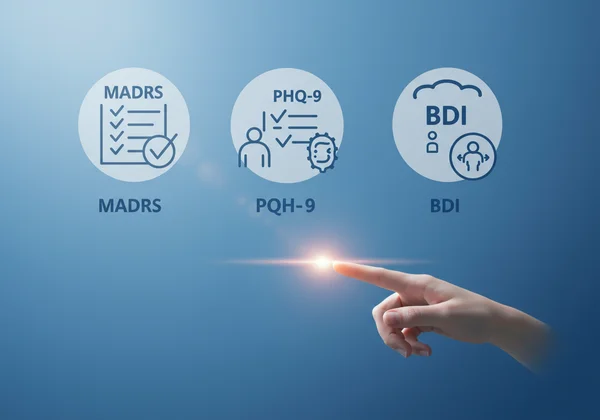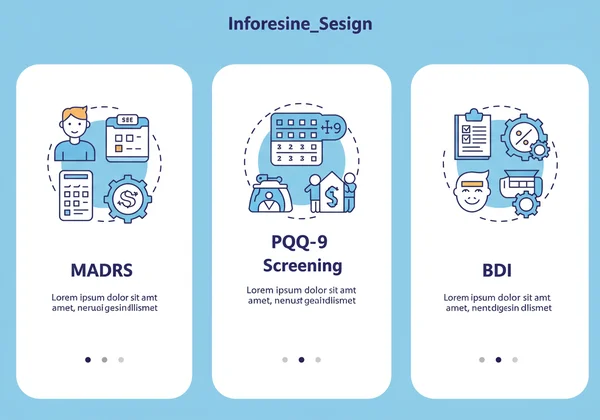MADRS vs. PHQ-9 vs. BDI: Choosing Your Depression Scale
Choosing the right depression assessment tool can be complex. Whether you're a clinician tracking treatment progress or an individual aiming to understand your symptoms, selecting the right scale is crucial. With options like the MADRS, PHQ-9, and BDI available, what is the difference between MADRS and PHQ9 and which one is most suitable for your needs? This guide will break down the purpose, strengths, and ideal applications of these three leading depression assessment tools.
Understanding these differences is key to gaining accurate insights. Whether for clinical monitoring or personal reflection, the right tool empowers better conversations about mental health. For those seeking a clinically trusted measure, you can take our MADRS assessment to get started.

Understanding the MADRS Scale: A Clinical Standard
The Montgomery-Åsberg Depression Rating Scale (MADRS) is widely regarded as a "gold standard" in clinical settings, especially within psychiatric research and practice. It was specifically designed to be sensitive to changes in depression severity, making it an exceptional instrument for monitoring the effectiveness of treatments like medication or therapy over time. Its focus is on the core psychic symptoms of depression.
What is the MADRS Scale & Its Purpose in Clinical Use?
This scale is a ten-item questionnaire that evaluates symptoms such as apparent sadness, reported sadness, inner tension, sleep disturbances, and suicidal thoughts. Unlike many other scales, it is traditionally administered by a trained clinician who interviews the patient to score each item. This expert-led approach allows for nuanced observation and clarification, capturing a depth of information that simple self-report forms might miss. Its primary purpose is not for initial diagnosis but for detailed tracking of a patient's journey through treatment, providing a reliable measure of progress.

Deciphering MADRS Scoring & Interpretation for Professionals
The MADRS scoring system ranges from 0 to 60. Each of the 10 items is rated on a 7-point scale from 0 to 6, where higher scores indicate greater severity. The total score provides a clear benchmark:
- 0-6: Normal / Symptom-free
- 7-19: Mild depression
- 20-34: Moderate depression
- >34: Severe depression
For professionals, these scores are invaluable for quantifying treatment response or remission. A significant drop in the score is a strong indicator that an intervention is working. For individuals, an accessible online version of this assessment can offer these same powerful insights, providing a clear score that you can then discuss with a healthcare provider. You can get your free score to understand where you stand.
Key Strengths & Potential Limitations of the MADRS
The greatest strength of the MADRS is its sensitivity to change. This makes it the preferred MADRS clinical tool for clinical trials and for practitioners who need to make informed decisions about adjusting treatment plans. It focuses on the most significant psychological symptoms, avoiding overlap with physical ailments that can sometimes confound results.
The primary limitation has historically been its reliance on a trained administrator, making it less accessible for quick screening or individual use. However, our online tool has bridged this gap by creating a structured, user-friendly online assessment that maintains the scale's integrity while making it available to a wider audience.
PHQ-9 vs. BDI: Distinctive Depression Assessment Tools
While the MADRS excels in clinical monitoring, the Patient Health Questionnaire-9 (PHQ-9) and Beck Depression Inventory (BDI) serve different, equally important roles. They are both self-report questionnaires, making them highly accessible and efficient.
The PHQ-9: A Concise & Widely Used Screening Tool
The PHQ-9 is a nine-item questionnaire based directly on the diagnostic criteria for major depressive disorder found in the DSM-5. Its brevity and ease of use have made it a go-to screening tool in primary care settings. Patients can complete it in minutes, giving doctors a quick and reliable snapshot of their mental state. It is excellent for identifying individuals who may need a more thorough evaluation.
The BDI-II: Comprehensive Self-Report for Symptom Severity
The Beck Depression Inventory, Second Edition (BDI-II), is a 21-item self-report instrument that provides a more detailed assessment of depressive symptoms. It places a significant emphasis on the cognitive aspects of depression, such as guilt, self-criticism, and pessimism. It is a powerful tool for individuals and therapists to gain a comprehensive self-report understanding of the nature and severity of a person's depressive experience.
Core Differences in Focus, Format & Administration
The three scales differ fundamentally in their design and application:
| Feature | MADRS | PHQ-9 | BDI-II |
|---|---|---|---|
| Administrator | Clinician-rated | Self-report | Self-report |
| Primary Use | Monitoring treatment response | Screening & initial assessment | Detailed symptom evaluation |
| Number of Items | 10 | 9 | 21 |
| Key Focus | Core psychic symptoms | DSM-5 diagnostic criteria | Cognitive & affective symptoms |

Choosing the Right Depression Assessment Tool for Your Needs
To choose a depression test that is right for you or your patients, consider the specific goal of the assessment. Are you conducting a quick check-in, exploring symptoms in-depth, or monitoring progress with high sensitivity?
When to Consider Each Scale: MADRS, PHQ-9, or BDI?
- Use the PHQ-9 for fast, efficient screening in a primary care or general health setting. It helps answer the question, "Is a further evaluation for depression warranted?"
- Use the BDI-II when you need a detailed, comprehensive self-inventory of a wide range of depressive symptoms, especially cognitive ones.
- Use the MADRS when the primary goal is to sensitively track changes in symptom severity over time, particularly in response to treatment. This is the standard for measuring therapeutic efficacy. Our online tool makes this powerful assessment accessible.
Important Considerations for Healthcare Professionals
For psychiatrists, researchers, and therapists, the MADRS remains the superior choice for tracking treatment outcomes in clinical practice and research. Its sensitivity ensures that even subtle improvements are captured. Integrating a tool like our MADRS assessment can streamline this process, saving time while providing patients with an instant score and an optional, AI-powered report for deeper, personalized insights.
Guidance for Individuals & Self-Assessment
If you are looking to understand your own symptoms, all three tools can be useful. However, if you are undergoing treatment or want to monitor your mental health closely, the MADRS provides the most nuanced feedback. Using a reliable online platform for a MADRS self-report gives you valuable data to bring to your doctor or therapist, fostering a more informed and collaborative discussion about your well-being.

Empowering Informed Choices in Depression Assessment
When deciding between the MADRS, PHQ-9, and BDI, consider your specific context and assessment goals. The PHQ-9 is an excellent screener, the BDI-II offers deep self-reported insight, and the MADRS stands as the clinical gold standard for monitoring change. Each tool provides a different lens through which to view and understand depression.
For those who need a reliable, sensitive, and clinically trusted measure to track their mental health journey, the MADRS is unparalleled. We invite you to experience the clarity it offers. Visit our free, confidential assessment tool today and discover the insights waiting for you.
Frequently Asked Questions About Depression Assessment Scales
What is the difference between MADRS and PHQ9?
The main difference is their purpose and administrator. The MADRS is a clinician-rated scale designed to be highly sensitive to changes from treatment, making it ideal for monitoring progress. The PHQ-9 is a quick, self-report screening tool used to identify potential cases of depression based on DSM-5 criteria.
How do you interpret MADRS scores?
MADRS scores range from 0 to 60, with higher scores indicating more severe depression. Generally, 7-19 is considered mild, 20-34 moderate, and over 34 severe. For a precise score and understanding, we recommend using a standardized tool like the free MADRS assessment on our site.
Can I use MADRS for self-assessment?
While traditionally clinician-administered, modern platforms like ours provide a structured and reliable way to complete a MADRS assessment on your own. This MADRS self-report can provide valuable insights to share with a healthcare professional, though it should not replace a formal diagnosis.
Is the MADRS test free?
Yes, you can take a free MADRS assessment on our platform. The test provides you with an immediate, confidential score to help you understand your current symptom severity. We also offer an optional, in-depth AI report for a more personalized analysis.